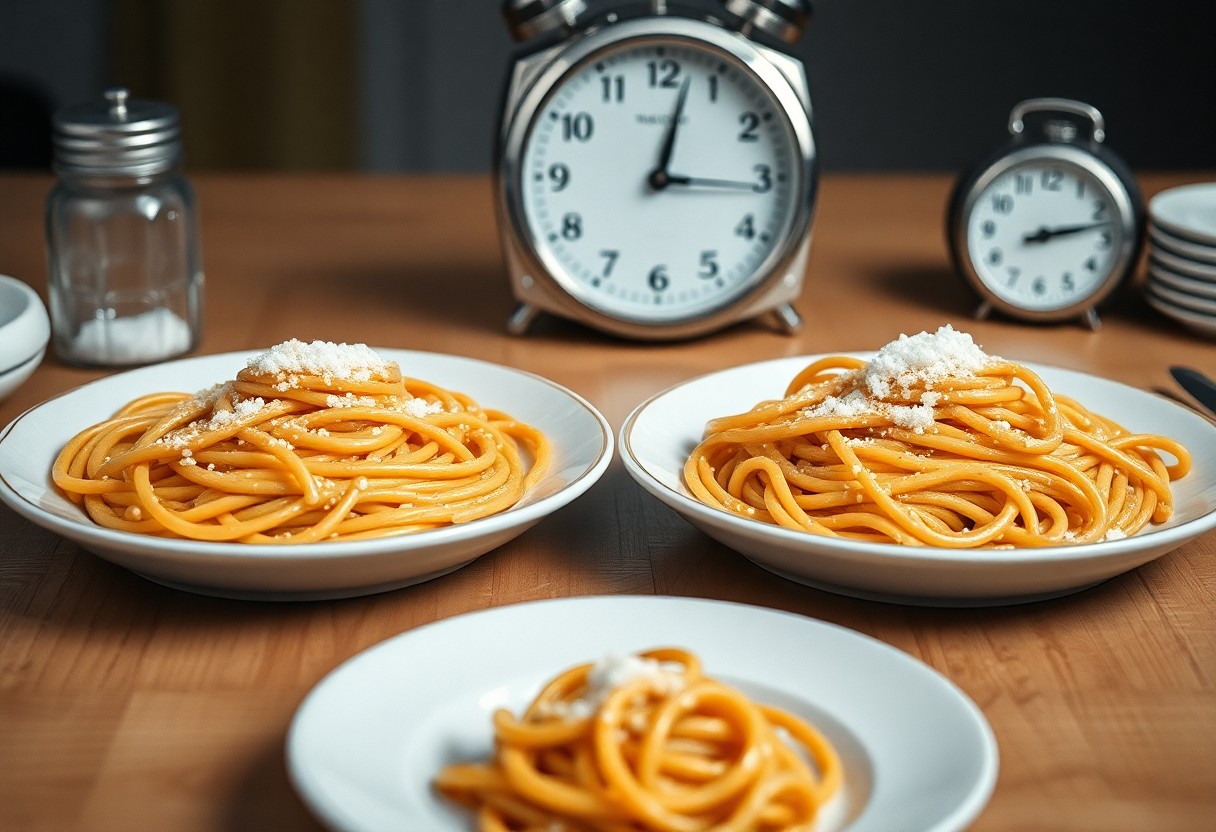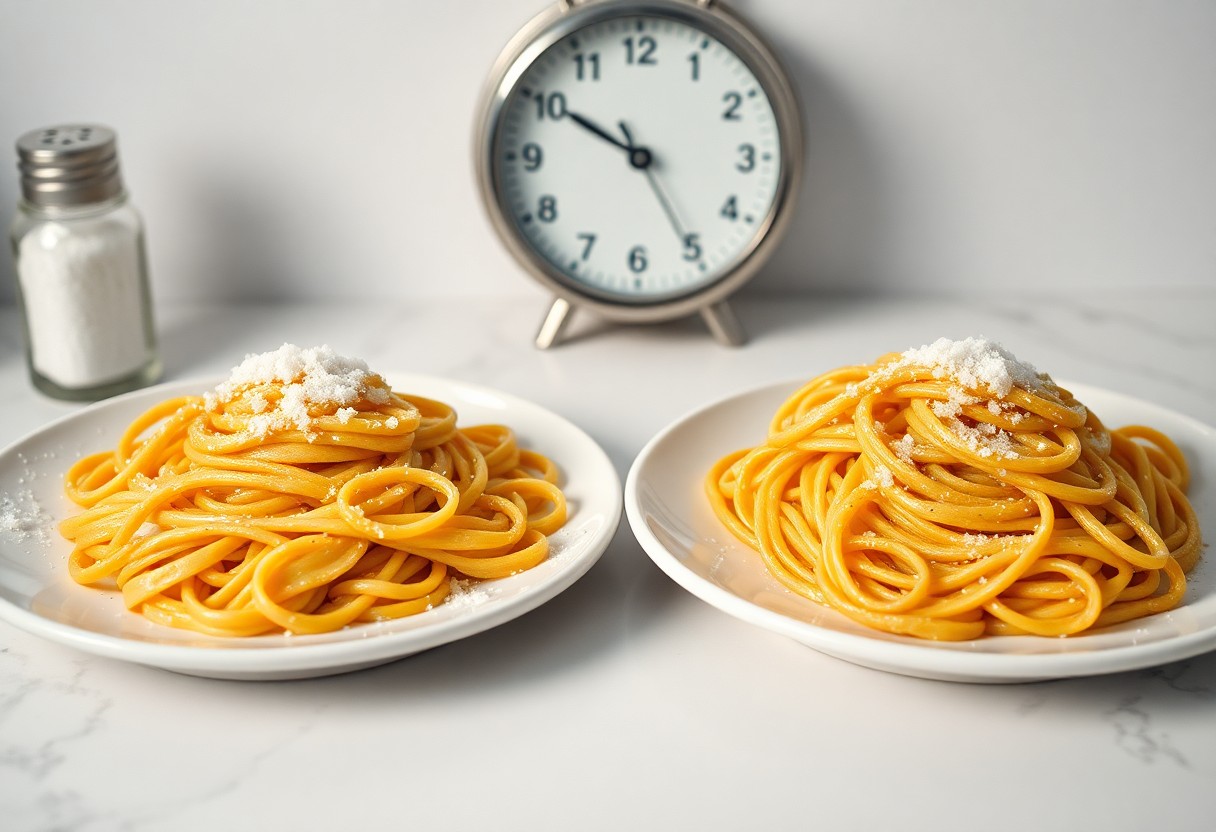Understanding salt’s role in cooking transcends mere seasoning; it’s an intricate blend of chemistry and creativity. Your choice of salt can significantly influence the final outcome of a dish. For example, kosher salt, with its large crystals, is perfect for seasoning meat, allowing for uniform coverage and a balanced flavor.
In contrast, finishing salts like fleur de sel or Maldon provide a delicate crunch and bursts of flavor when sprinkled just before serving. The interplay of texture and taste not only enhances your dish’s profile but also engages the palate in delightful surprises.
Each type of salt carries its unique mineral content and moisture levels, which can affect the dish’s overall flavor and mouthfeel.

Key Takeaways:
- Adding salt at the right stage of cooking can significantly influence the flavor profile of a dish; too early can lead to overly salty dishes, while too late may not allow the salt to fully enhance the flavors.
- Salting proteins early can help in moisture retention and improve texture, while salting vegetables late in the cooking process can help maintain their natural crunch and flavor.
- Conducting taste tests can reveal the difference in flavor when adjusting salt timing, highlighting how important it is to consider when and how much salt to add during cooking.
The Impact of Timing on Flavor Development
The timing of salt application during cooking dramatically shifts your food’s flavor profile. Salt interacts with proteins and carbohydrates, enhancing their natural characteristics through chemical reactions.
Early salting draws out moisture, intensifying flavors as the food cooks, while later salting can elevate the final dish’s taste without compromising its texture.
Understanding this balance impacts not only the taste but also the overall experience of your meal. Curious about the science behind salt’s flavor-enhancing properties? Check out Why does salt make food taste so good?
Early Seasoning: Enhancing Natural Flavors
Applying salt during the initial cooking stages amplifies the food’s inherent flavors. When you season early, salt helps catalyze flavor compounds, allowing them to mingle and deepen as the dish simmers or bakes. Vegetables, for example, release their natural sugars more readily when salted before cooking, resulting in a richer, more complex taste that elevates the dish as a whole.
Late Seasoning: Preserving Texture and Balance
In contrast, adding salt at the end of the cooking process can maintain the desired texture of your ingredients. This technique is particularly effective for dishes where crispness or tenderness is crucial, such as salads or delicate proteins.
By seasoning last, you preserve the visual appeal and mouthfeel of your dish, ensuring that the salt enhances the flavor without overpowering other elements. This approach allows for a balanced taste where salt complements instead of dominates.
Delaying the addition of salt is especially valuable in dishes with multiple layers of seasoning and diverse textures, like stir-fries or gourmet salads. You’ll want crisp vegetables to maintain their bite and fresh herbs to retain their vibrant flavor.
For example, sprinkling flaky sea salt just before serving can enhance the overall taste while preserving the integrity of your ingredient’s textures. This technique allows the salt to act as a finishing touch, creating an exquisite balance of flavors and sensations in your dish.
Salt Types and Their Reaction to Time
Understanding the different types of salt and how they react over time is imperative for any cook. Different salts possess unique crystal structures and chemical compositions, affecting how they interact with food. For instance, finely ground salt dissolves quickly, while coarser salts linger longer, which can impact the timing of their incorporation. Below is a comparison of key salt types and how their timing affects your cooking.
| Salt Type | Reaction to Time |
| Kosher Salt | Slow dissolution; great for seasoning meat |
| Table Salt | Fast dissolution; can easily dominate flavor |
| Sea Salt | Variable; enhances texture and crunch based on size |
| Finishing Salt | Sparse application; brightens flavor at the end |
| Rock Salt | Very slow dissolution; used primarily for brining |
Recognizing the characteristics of each salt type allows for better control over your seasoning strategy, improving both texture and flavor in your dishes.
Kosher vs. Table Salt: A Chemical Perspective
Kosher salt, with its larger, flakier crystals, provides a more forgiving seasoning option compared to the finer grains of table salt. The mineral composition also differs; table salt is often iodized, which can introduce a slight metallic flavor. With kosher salt, the flavor is clean and pure, allowing for easier control over seasoning during cooking. This granularity makes it a preferred choice for chefs seeking to season meats or vegetables effectively.
Sea Salt and Finishing Salt: When to Use Them
Sea salt and finishing salt have distinct roles in cooking that can elevate your dishes. Sea salt is harvested from evaporated seawater and often retains trace minerals that impart subtle flavors. In contrast, finishing salts, like fleur de sel, are used at the end of cooking to add texture and bursts of flavor on the finished dish. You should sprinkle sea salt as you cook, but reserve finishing salts for that final touch.
When using sea salt, consider its texture and flavor profile at different stages of cooking. For example, incorporating it early in the preparation process might lead to a more blended flavor, while adding it at the end highlights its unique crunch and essence. Finishing with a light sprinkle enhances presentation and can create a delightful contrast in mouthfeel.

Taste Test: A Side-by-Side Comparison
Salt Timing Comparison
| Salted Early | Salted Late |
|---|---|
| Enhanced umami flavors | Brighter, fresher taste |
| More complex overall profile | Sharp, well-defined seasoning |
| Textural integrity preserved | Direct flavor impact |
Methodology: How We Tested Salt Timing
To examine the effects of salt timing, you prepared two identical batches of a savory dish. One batch received salt during the initial cooking phase, while the other was seasoned just before serving. Each version was rated based on flavor intensity, balance, and overall satisfaction by a select group of taste testers.
Results: What Our Palate Revealed
The taste test highlighted clear differences in flavor profiles. Those who sampled the early-salted dish appreciated the deep layers of umami that developed, while participants favored the late-salted version for its bright and fresh flavor. This confirms that timing significantly alters your dining experience.
The testing revealed that salt’s role is more complex than mere seasoning; it fundamentally influences how ingredients interact during cooking. Tasters found the early-salted dish richer and more integrated, emphasizing the fusion of flavors.
Conversely, the late-salted version stood out for its clear, sharper taste, making individual components more pronounced. Thus, adjusting salt timing can drastically tailor the dish’s overall flavor, offering you options depending on the desired outcome.
Implications for Home Cooks and Chefs
The timing of your salt application can significantly influence both the flavor and texture of your dishes, meaning that understanding these implications can elevate your culinary skills. As a home cook or chef, your ability to adjust salt timing can enhance the taste and texture of everything from simple vegetables to complex sauces. It can even transform the outcome of a dish, allowing for a precise balance of flavors that keeps diners coming back for more.
Practical Tips for Timing Salt Right
Salt timing can be your secret weapon in the kitchen. Here are some effective strategies:
- Season early during the marinating process to allow flavors to develop.
- Sprinkle at different stages while cooking for balanced seasoning.
- Adjust for texture by salting before roasting to achieve crispy exteriors.
- Use finishing salts for topping dishes right before serving.
Assume that refining your timing will lead to a more profound culinary experience for you and your guests.
Culinary Myths Debunked: Separating Fact from Fiction
Many myths surround salt application and timing, creating confusion for cooks. For instance, the belief that salting meat draws out moisture is a common misconception; in fact, when done correctly, it enhances flavor and tenderness.
Additionally, some think salt should only be added at the very end, neglecting its benefits when introduced at early stages of cooking to build complexity. Understanding these nuances can empower your culinary decisions and help you achieve your desired results.
Coupled with the science of salt timing, busting these culinary myths can significantly improve your cooking. For example, salting potatoes before boiling them is often frowned upon due to concerns about mushiness, but doing so actually helps enhance flavor.
Similarly, the myth about retaining all moisture by salting meat late overlooks the fact that early seasoning encourages flavor penetration and moisture retention. By discerning fact from fiction, you’ll elevate your cooking techniques, leading to enhanced dishes that speak to your skill and understanding of culinary science.
FAQ
Q: Why does the timing of adding salt during cooking matter?
A: The timing of adding salt is significant because it can affect the texture and flavor of the final dish. Adding salt early in the cooking process allows it to penetrate and enhance the overall flavor; however, it can also draw out moisture from vegetables and meats, potentially resulting in a less juicy texture. On the other hand, adding salt too late may not provide the same depth of flavor, as it doesn’t have the same opportunity to meld with the other ingredients.
Q: How does adding salt at different stages impact the taste of a dish?
A: The stage at which salt is added can lead to variations in taste. When salt is introduced at the beginning, it helps to build a more layered flavor profile, as it interacts with the ingredients over time. If added towards the end, it may provide a sharp, concentrated flavor that doesn’t distribute as evenly throughout the dish. Taste tests have shown that early salting generally leads to a more harmonious flavor, while late salting can result in an unbalanced taste.
Q: What are the scientific reasons behind adding salt at specific times during cooking?
A: Scientifically, salt alters the structure of protein and carbohydrate molecules. When added at the beginning, it helps proteins to unfold and interact with other ingredients, enhancing flavors and improving the overall mouthfeel. Additionally, salt can enhance the perception of sweetness and mitigate bitterness, depending on when it is added. Conversely, adding salt at the end may not allow these interactions to occur fully, leading to a less complex flavor profile.
Q: Are there specific types of dishes in which salt timing is particularly important?
A: Yes, the importance of salt timing can vary based on the dish. For example, in soups, stews, or braised dishes, early salt addition can enhance flavor integration. For vegetables, salting them early can draw out moisture and improve texture. In contrast, delicate dishes like fish or certain sauces benefit from late salt addition to maintain their subtle flavors and prevent them from becoming overly salty. Each dish has its unique requirements in regards to salt timing.
Q: How can I effectively test the difference timing of salt makes in my cooking?
A: To effectively test the impact of salt timing, try making the same dish twice: once with salt added at the beginning and once with it added at the end. Pay attention to texture, flavor depth, and how saltiness is perceived. Conducting a blind taste test with friends or family can also help you gauge their preference, making it easier to discern the significant differences the timing of salt makes on the dish’s final outcome.

Alden Pierce is a passionate home cook and the creator of Cooking Again. He loves sharing easy recipes, practical cooking tips, and honest kitchen gear reviews to help others enjoy cooking with confidence and creativity. When he’s not in the kitchen, Alden enjoys exploring new cuisines and finding inspiration in everyday meals.
